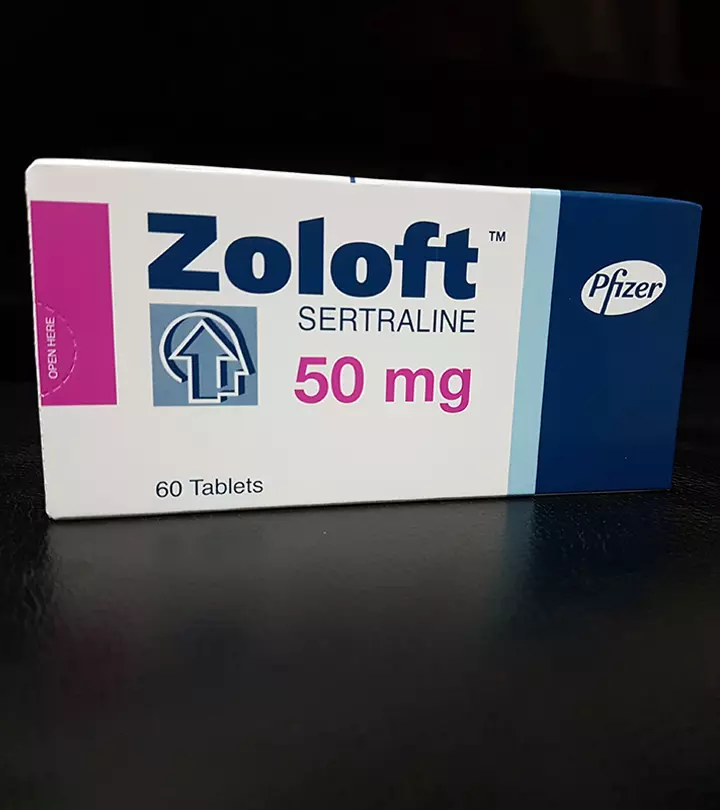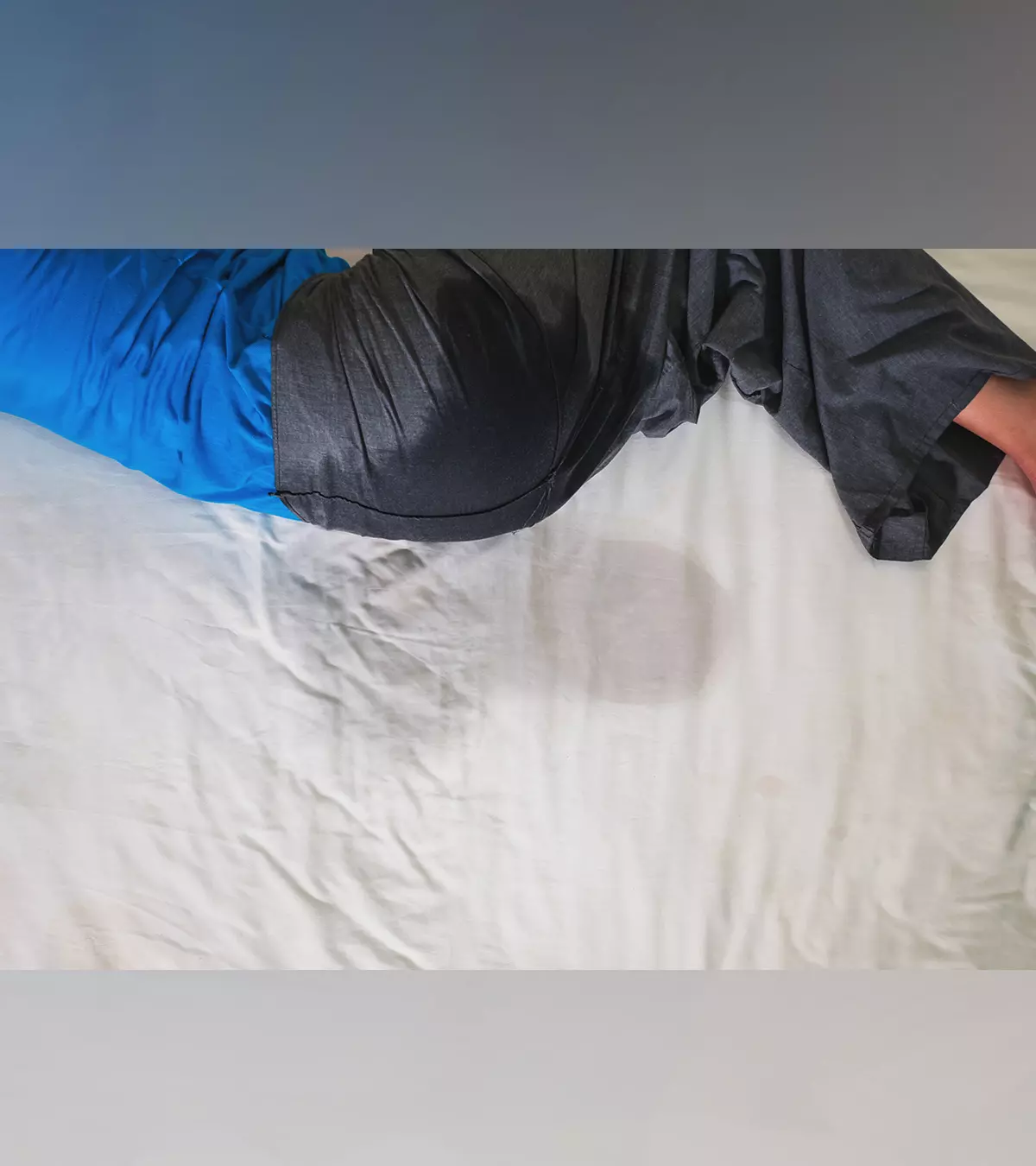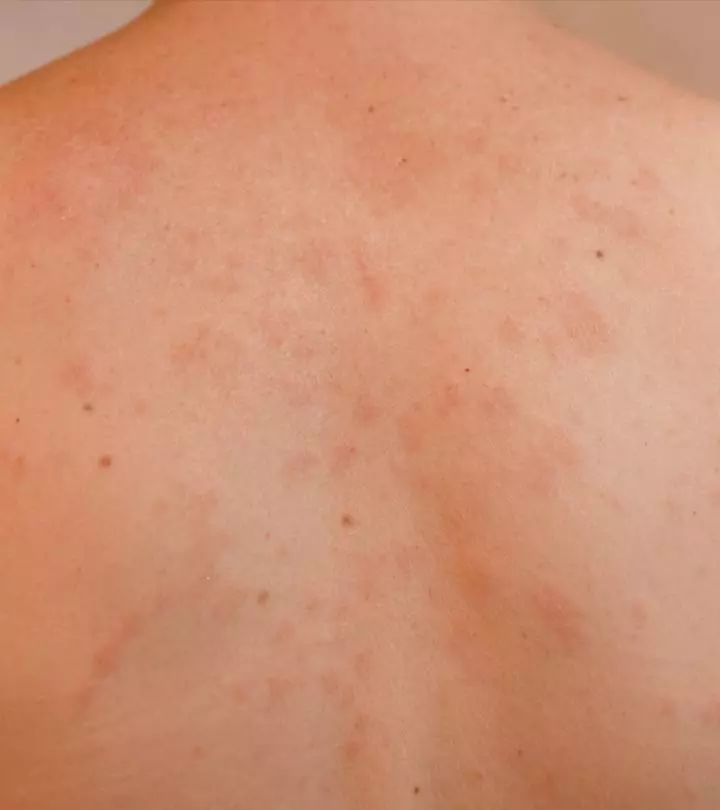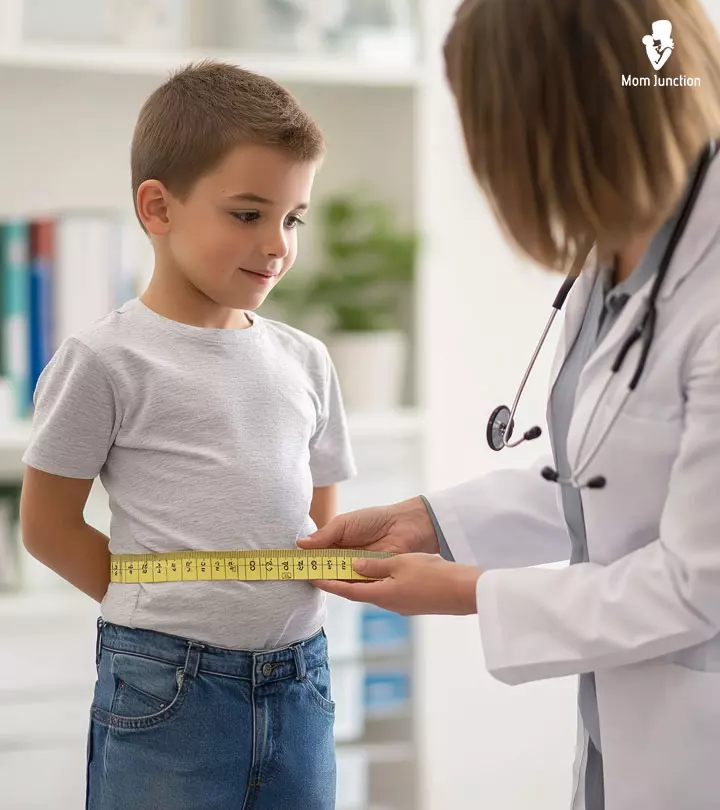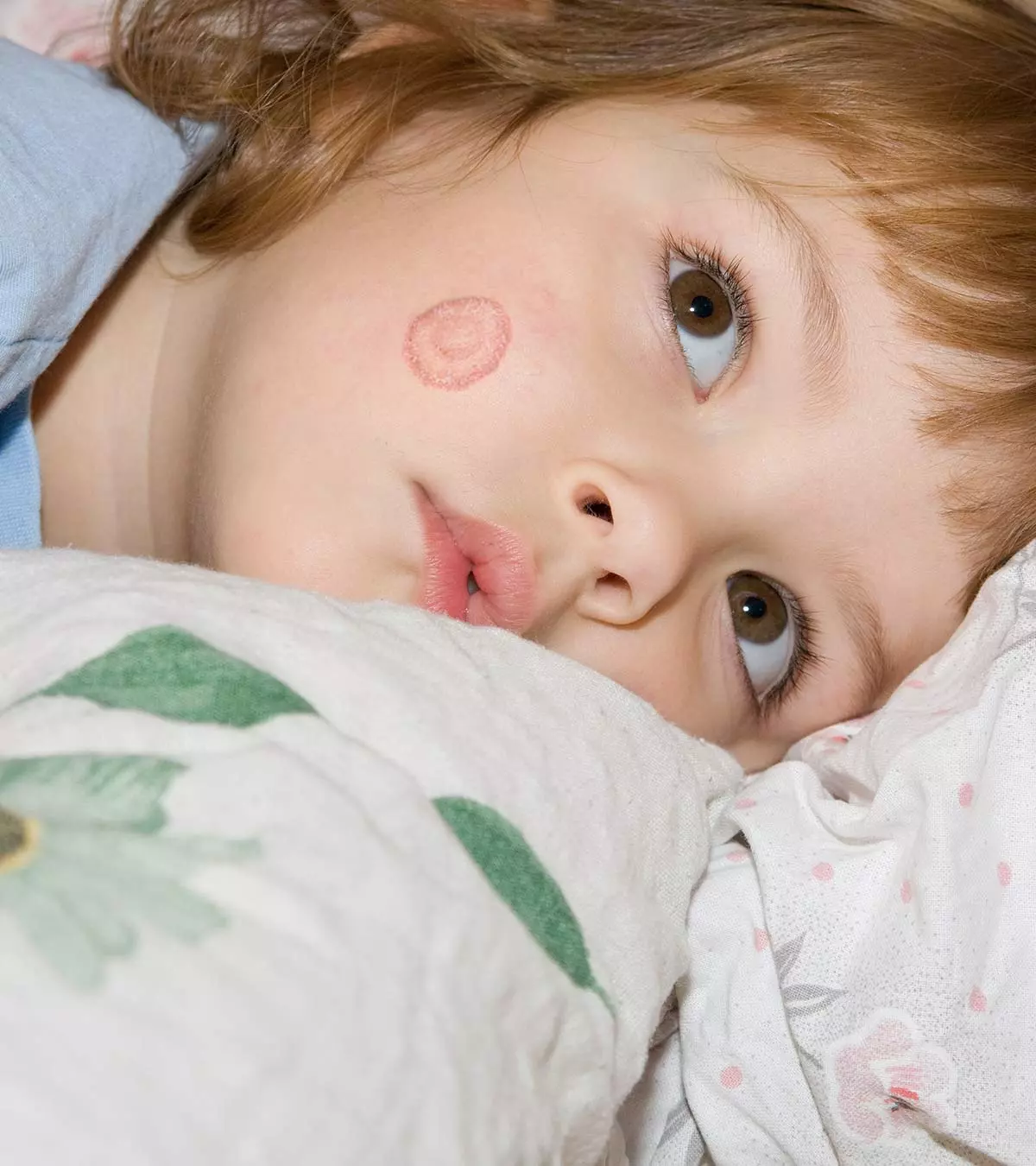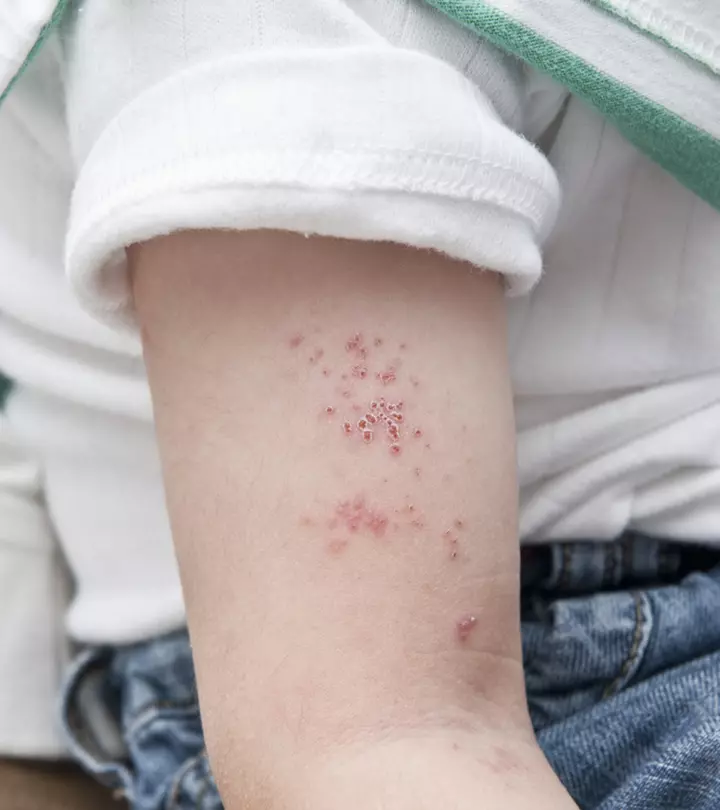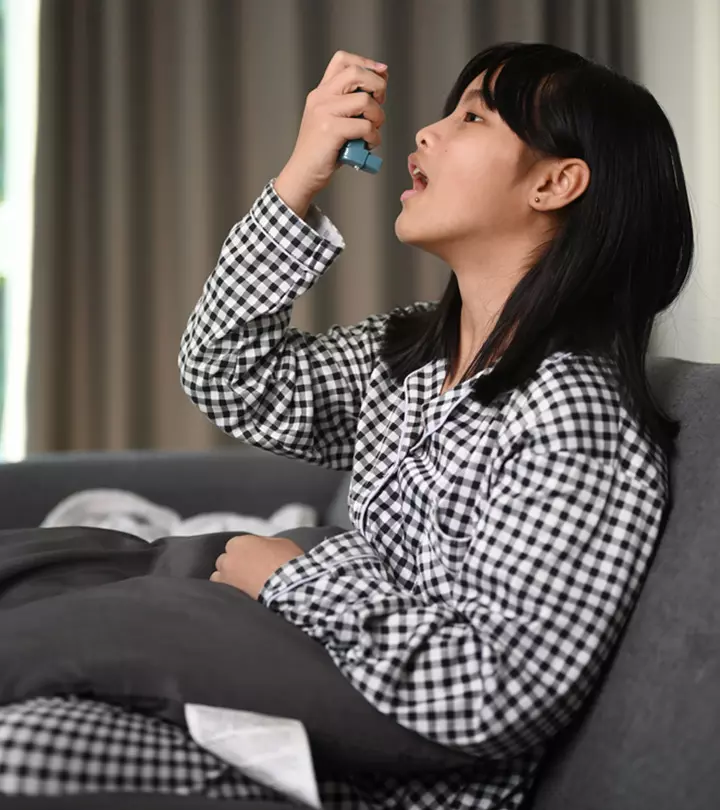
Image: Shutterstock
Family doctors and physicians frequently encounter cases of wheezing in children. The wheezing sound is mostly caused when air is trying to move through the narrow or constricted airway of the lungs (1). According to a study shared by the American Academy of Family Physicians, wheezing is as prevalent as in 40% of the pediatric population by the age of three, and nearly half of all children will have experienced at least one wheezing episode by the age of six (2) (3).
Read this post to learn the types and causes of childhood wheezing and how it can be diagnosed and managed.
Key Pointers
- Wheezing is a whistling or high-pitched sound usually heard when breathing out or exhaling.
- Most children experience at least one episode of wheezing.
- Common causes of wheezing include respiratory infections and allergies.
- Persistent wheezing may indicate asthma, which requires long-term management.
- Home remedies, such as using a cool-mist humidifier and serving more fluids, can ease wheezing in most children.
Symptoms Of Wheezing In Children
Wheezing in children is characterized by (1):
- High-pitched breathing
- A purring or whistling sound
The wheezing sound is most obvious while your child is exhaling or breathing out.
Causes Of Wheezing In Children
Several conditions and factors can lead to wheezing in children (2) (3).
- Children younger than five years often experience wheezing due to asthma (4). Asthma is likely to be the source of episodic or recurrent wheezing, which is linked to seasonal triggers, such as pollen. According to the Centers for Disease Control and Prevention (CDC), from 2016 to 2018, about 8.1% of children between 0 and 17 had asthma.
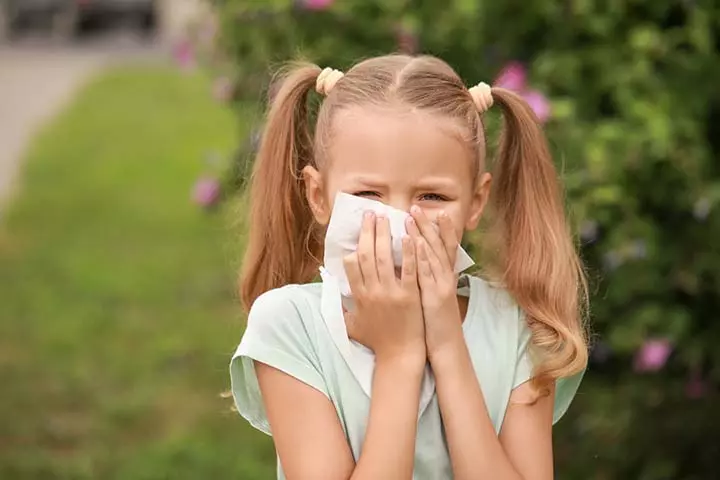
Image: Shutterstock
- Wheezing accompanied by nasal flare-up and intercostal retractions (reduced air pressure inside the chest) could occur due to bronchiolitis (a respiratory syncytial virus infection), allergies, or croup (an infection of the upper airway).
- A child may experience wheezing cough and feeding-associated vomiting due to gastroesophageal reflux disease (GERD), also known as acid reflux in children.
- Respiratory infections, such as bronchitis, chronic obstructive pulmonary disease, and pneumonia, can cause breathing problems, shortness of breath, and wheezing.
- If your child’s wheezing wakes them up at night and is accompanied by snoring, it may be due to obstructive sleep apneaiA sleep disorder that develops when the windpipe is blocked, resulting in breathing difficulty. .
- Wheezing and sharp whistling sounds while breathing, especially during cold, cough, and allergies in children, may indicate nasal congestion (blocked nose) and chest congestion or chest tightness.
- Certain craniofacial anomaliesiDifferent types of face and head abnormalities present from birth. and congenital abnormalitiesiA structural or functional abnormality present from birth. could lead to wheezing in infants and younger children.
- Various environmental factors, such as foreign body aspiration, may also cause wheezing, accompanied by symptoms like runny nose and sneezing.
Research indicates that some children may experience wheezing due to maternal factors during pregnancy, such as maternal smoking, low iron levels, low vitamin D levels, obesity, and poor folic acid intake (5).
Amanda Ryan, a mother, shares her son’s experience due to undiagnosed asthma. She says, “It started with what seemed like a harmless respiratory illness. Dawson had a persistent cough, occasional wheezing, and had been feeling extremely tired. We initially thought it was a common cold or seasonal allergies. However, as the days went by, his symptoms worsened, and we became increasingly concerned (i).” She urges parents to keep strict vigilance of the symptoms of illness of their children and seek medical help before the illness becomes severe.
 Point to consider
Point to considerTypes Of Wheezing In Children
Wheezing in children can be of the following types depending on its pattern and duration (5).
- Episodic wheeze is usually caused by a viral cold where your child may wheeze for a short period in between episodes.
- Multi-trigger wheezing in children may occur with/without evidence of an acute viral infection.

Image: Shutterstock
- Never or infrequent wheeze refers to wheezing in children for at least once in their life.
- Transient early wheeze begins in the first year of life and lasts through the second year before subsiding after the third year. It is mostly caused by factors such as maternal smoking or exposure to smoke, preterm birth, low maternal age, and low birth weight.
- Intermediate wheeze can start between the ages of 1.5 and 3.5 years and last throughout later childhood. It is linked to allergy sensitization and lower pulmonary function test (PFT)iA non-invasive test used to assess how well the lungs are functioning by testing the breathing. scores.
- Late-onset wheeze is most commonly associated with nasal allergies, and it occurs more frequently in children aged three to six years.
- Persistent wheezing can occur due to asthma, severe respiratory infection, or constant exposure to an allergen.
When To Call A Doctor
Although wheezing is not harmful, you should immediately call a healthcare provider if the child has (6):
- Difficulty breathing
- Sudden onset of wheezing after a bee sting, taking medicine, or eating a food item
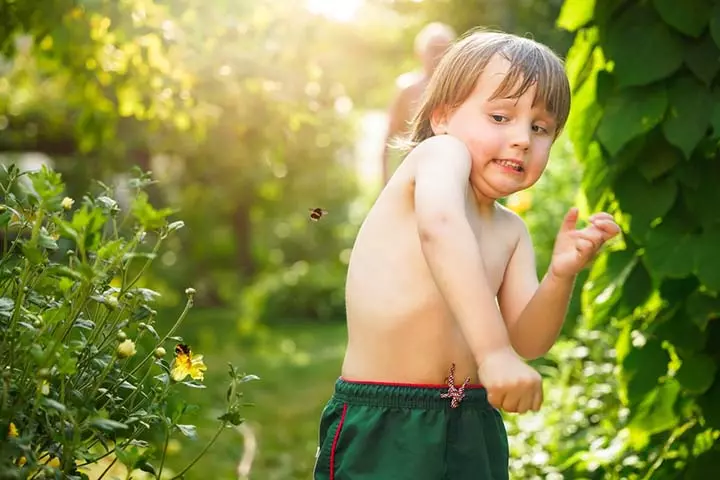
Image: Shutterstock
- Become unconscious or stopped breathing
- Bluish or pale lips or face
- Unusual fatigue
- Recently choked on a small object or food
- Rapid or uneven breathing
- Temperature over 98.6°F (37°C)
- Been refusing to drink or eat
Diagnosis Of Wheezing In Children
In most cases, wheezing can be clinically diagnosed. Your child’s doctor would obtain (2) (5):
- Detailed family history and clinical history of a child
- Detailed information on the type of wheezing and associated symptoms
- Pattern and seasonality of wheezing
If your child has chronic and persistent wheezing, the doctor may prescribe additional tests to find the underlying cause.
- Physical examination, especially in chronically ill children, to check for any signs of metabolic disorders, immunodeficiencies, or cystic fibrosis.
- Chest radiographs include chest X-rays or a chest CT scan to detect any structural anomalies or foreign body aspirations.
If a certain etiology is suspected in your child, the doctor may suggest:
- SpirometryiA routine lung function test that measures how much air is inhaled and exhaled. to detect asthma
- If an allergy is suspected, a radioallergosorbent testiA blood test used to determine whether a person has an allergy to a particular substance. , skin test, or immunoglobulin assayiTest that checks for antibodies in the blood. can be used to evaluate IgE levels
- A complete blood count to detect eosinophilia
- Barium meal testsiMedical test that checks for irregularities in the stomach, esophagus, and small intestine using an X-ray. to detect gastrointestinal structural problems
- A pH test if your child is showing symptoms of GERD
- A swallowing assessment if a foreign body aspiration is being suspected
Treatment For Wheezing In Children
The treatment may differ depending on the type and underlying cause of wheezing in children. Some of the pharmacological treatments of wheezing may include the following (5).
- Bronchodilator: These are drugs that dilate the bronchi and make it easier for the child to breathe. In mild cases of wheezing, your child’s doctor may preferably prescribe bronchodilator therapy with a metered-dose inhaler and nebulizer.
- Corticosteroids: If your child has recurrent and persistent or late-onset wheezing, inhaled corticosteroids can be effective. A short course of systemic steroids may be prescribed if your child has recurrent wheezing after a respiratory infection.
Some other medicines include antibiotics for bacterial infections and antihistamines to manage allergies. Antileukotrienes reduce inflammation and associated obstruction. Do note that asthma medication can only be administered to children aged over 12-18 months (1).
Ensure regular visits to the doctor to track the condition and evaluate how well the treatment is working. Also, ensure your child takes the prescribed medications to keep the symptoms under control, reduce flare-ups, and enhance the child’s quality of life.
Home Remedies For Wheezing In Children
If your child has mild wheezing, you may try some of these remedies for symptomatic relief after consulting your healthcare provider (3) (6).
- Let your child breathe warm mist, such as with a shower running in a closed bathroom.
- Serve plenty of fluids, such as homemade lemonade, soups, and broth, to ease any irritation in the airways.
- Use homemade or over-the-counter saline (saltwater) nose drops to loosen up dried nasal mucus.
- Place a cool-mist humidifier in the child’s room.
- Prevent exposure to tobacco smoke, exhaust from automobiles, and volatile chemicals.
 Caution
CautionFrequently Asked Questions
1. What happens if wheezing is left untreated in children?
Wheezing is often a symptom of underlying problems, such as asthma, allergy, heart conditions, or chronic bronchitis in children (7). If these conditions are left untreated, they may lead to severe complications and long-term effects (8).
2. How can one tell if wheezing is from the lungs or throat?
Wheezing is generally from an obstruction in the lungs. Your doctor can listen to your breathing sound and distinguish if it comes from the lungs or throat. If the sound is high pitched only while exhaling, it is most likely wheezing from the lungs. If the sound is even higher pitched and occurs either while exhaling or inhaling, it may come from the throat and is most likely a stridor (9).
3. Can wheezing in children lead to long-term health problems?
Recurrent wheezing in a child is suspected to be because of asthma. If left untreated, it may lead to several complications like severe asthma attacks or flare-ups, frequent hospitalizations leading to missed school, and even permanent lung damage (11). Therefore, it is recommended to consult a doctor promptly for accurate diagnosis and treatment.
4. Is there anything that can make wheezing worse in children?
Environmental allergies, mold, animal dander, strong smells of cleaning products or even cooking spices, and dust mite allergen are some triggers that may make wheezing worse (12).
5. Can secondhand smoke cause wheezing in children?
Yes, exposure to secondhand smoke can irritate and inflame a child’s lungs and cause them to produce more mucus than usual (13). It can also lead to other respiratory symptoms, such as coughing, chest congestion, and shortness of breath.
Wheezing in children may often subside as they grow older, but it may persist in those with chronic conditions such as asthma. Speak to the child’s doctor to learn ways to manage persistent wheezing. You may take note of the triggers that lead to wheezing episodes and avoid them. Adequate rest and care can help prevent wheezing in children due to infections and allergies.
Infographic: What Are The Different Types Of Wheezing In Children?
Wheezing can occur in various forms, each with distinct causes, signs, and therapies. Understanding the various types of wheezing in children helps you determine the underlying cause and ensure they receive the right treatment. Check out the infographic below to learn about them.
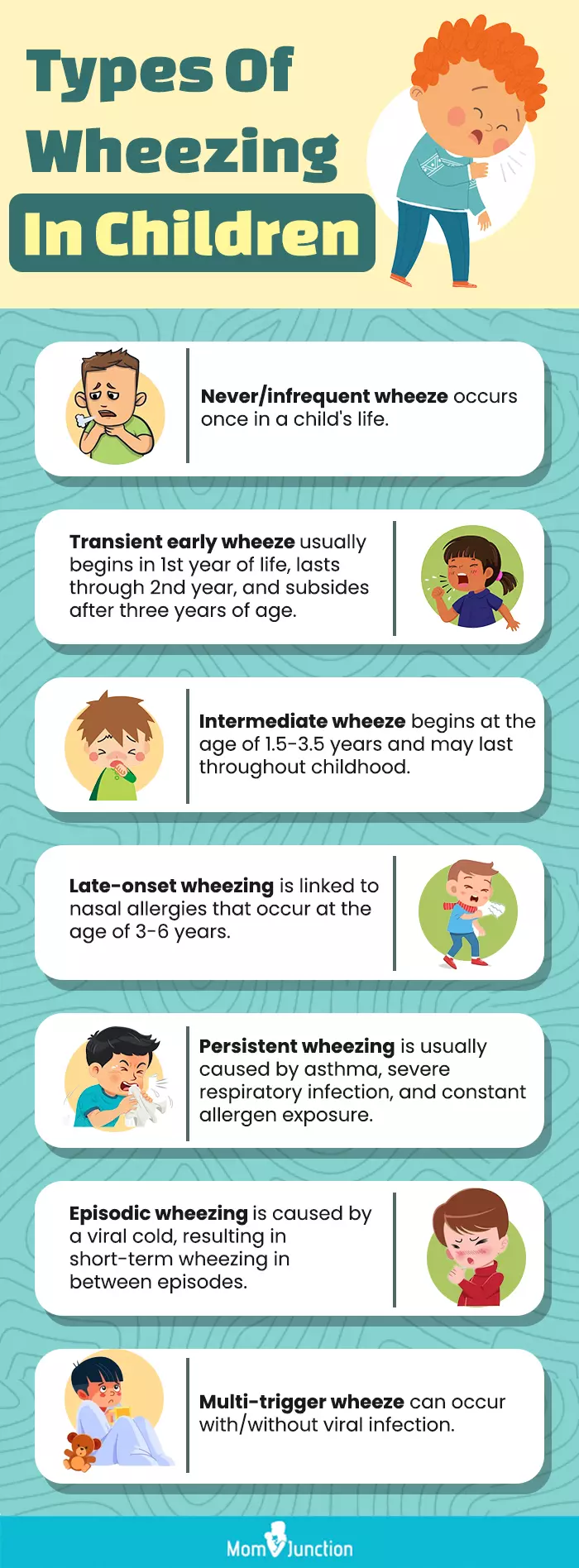
Illustration: Momjunction Design Team
Illustration: Causes Of Wheezing In Kids Symptoms And Home Remedies

Image: Dall·E/MomJunction Design Team
Personal Experience: Source
MomJunction articles include first-hand experiences to provide you with better insights through real-life narratives. Here are the sources of personal accounts referenced in this article.
i. A Mother’s Warning: Respiratory Illness and Undiagnosed Asthma.https://medium.com/spoonie-society/a-mothers-warning-respiratory-illness-and-undiagnosed-asthma-2da0ba4e2e27
References
- Wheezing in children.
https://www.healthywa.wa.gov.au/Articles/U_Z/Wheezing-in-children - Lisa Noble Weiss; (2008); The Diagnosis of Wheezing in Children.
https://www.aafp.org/pubs/afp/issues/2008/0415/p1109.html - Wheezing.
https://www.stlouischildrens.org/health-resources/symptom-checker/wheezing - Asthma in children.
https://www.aafp.org/pubs/afp/issues/2008/0415/p1109.html#:~:text=The%20most%20common%20causes%20of,body%20aspiration%2C%20and%20cystic%20fibrosis. - Abdullah Al-Shamrani et al.; (2019); Wheezing in children: Approaches to diagnosis and management.
https://www.ncbi.nlm.nih.gov/pmc/articles/PMC6676316/ - Coughing and wheezing in children.
https://www.betterhealth.vic.gov.au/health/conditionsandtreatments/coughing-and-wheezing-in-children - Wheezing.
https://my.clevelandclinic.org/health/symptoms/15203-wheezing - Asthma and Reactive Airway Disease (RAD) (Wheezing).
https://www.nationwidechildrens.org/conditions/asthma-and-reactive-airway-disease-rad-wheezing - Noisy breathing.
https://www.nationwidechildrens.org/conditions/noisy-breathing-stridor - Every Parent’s Guide to Wheezing in Children.
https://www.sitarambhartia.org/blog/pediatrics/wheezing-in-children/ - Childhood Asthma
https://my.clevelandclinic.org/health/diseases/6776-asthma-in-children - How parents can help kids avoid asthma attacks and control symptoms
https://utswmed.org/medblog/pediatric-asthma-tips-parents/ - Asthma in Children and Second-Hand Smoke
https://www.balladhealth.org/childrens-resource-center/asthma-smoking
Community Experiences
Join the conversation and become a part of our nurturing community! Share your stories, experiences, and insights to connect with fellow parents.
Read full bio of Dr. Elna Gibson
Read full bio of Reshmi Das
Read full bio of Dr. Ritika Shah
Read full bio of Dr. Joyani Das








